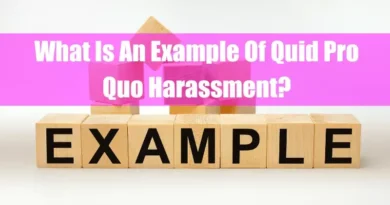Verbal and Non-Verbal Quid Pro Quo Behaviors
Takeaways
| Key Points |
|---|
| Verbal quid pro quo behaviors involve explicit requests, such as offering job benefits or threatening negative consequences in exchange for personal or sexual favors. |
| Examples include direct requests, sexualized comments, and subtle threats like, “If you want that promotion, you’ll need to do something for me.” |
| Non-verbal quid pro quo behaviors are more subtle and can include physical advances, suggestive gestures, or digital communications that imply sexual expectations. |
| Both verbal and non-verbal quid pro quo behaviors create a coercive workplace where individuals feel pressured or manipulated, undermining workplace morale and professional integrity, creating a hostile environment. |
| Non-verbal quid pro quo behaviors, such as ambiguous gestures or digital communication, are harder to prove since they may feel subjective or unclear to the victim, leaving them confused or unsure how to respond. |
Introduction
Quid pro quo behaviors involve a power dynamic in which someone in a position of authority offers or withholds job-related benefits (such as promotions or raises) or threatens penalties (like demotion or negative evaluations) depending on another person’s acceptance or rejection of specific actions, frequently involving sexual favors.
Verbal quid pro quo behaviors typically feature explicit requests, such as offering job benefits in exchange for personal favors or threatening negative consequences if such favors are refused. Non-verbal quid pro quo behaviors, though more difficult to detect, may include physical advances, suggestive gestures, or implied expectations that personal favors are necessary for professional opportunities. These non-verbal actions often occur alongside verbal propositions.

These behaviors create a coercive environment where individuals may feel pressured or manipulated, fostering a hostile or intimidating workplace. The person in power leverages their authority to influence another’s career for personal gain, undermining workplace morale and professional integrity.
Here is a table for Verbal vs. Non-Verbal Quid Pro Quo Behaviors:
| Aspect | Verbal Quid Pro Quo Behaviors | Non-Verbal Quid Pro Quo Behaviors |
|---|---|---|
| Medium of Communication | Spoken language, direct and indirect verbal cues | Body language, facial expressions, gestures |
| Clarity | Generally more straightforward and explicit | More subtle and can be ambiguous |
| Examples | Workplace requests for favors, social exchanges of help | Workplace gestures of support, social non-verbal signals of agreement |
| Effectiveness | Effective in formal settings due to clarity | Effective in informal or sensitive situations requiring discretion |
| Detection | Easier to identify due to direct statements | Challenging to detect due to subtle cues |
| Contextual Understanding | Requires understanding of language and situational context | Requires keen observation of physical cues and situational context |
| Impact | Can lead to clear mutual agreements or explicit exploitation | Can foster trust and support or cause misunderstandings and discomfort |
Verbal Quid Pro Quo Behaviors
Verbal quid pro quo harassment occurs when someone uses explicit words or suggestions to coerce or manipulate another person into providing favors in exchange for job security, promotions, or other benefits.

Direct Requests for Favors
In verbal quid pro quo situations, a superior might explicitly state the expected favor in exchange for job-related perks. For example, an employer might say, “If you want that promotion, you’ll need to do something for me,” implying the demand for personal or sexual favors.
Sexualized Comments or Suggestions
Verbal quid pro quo harassment can include sexually suggestive comments or inappropriate suggestions that imply a trade for job-related benefits. For example, comments like, “We could work out a special deal,” may carry an implied demand for sexual favors in exchange for career advancement, even if the request is not explicitly stated. Compliments that cross into personal territory making the recipient uncomfortable, can also fall into this category if they suggest professional rewards or consequences based on compliance.
Threats of Negative Consequences
A more insidious form of verbal harassment is when the person in power threatens retaliation or negative consequences, such as demotion or termination if the victim refuses to comply. For example, “If you don’t go to dinner with me, I’ll have to reconsider your performance evaluation” can be a veiled threat designed to manipulate the subordinate.
Non-Verbal Quid Pro Quo Behaviors

Non-verbal quid pro quo behavior is more subtle but equally damaging. It may involve physical gestures, body language, or even suggestive digital communications with implicit promises or threats. Non-verbal cues can sometimes make it more difficult for victims to prove harassment, as they may feel the behavior was ambiguous or subjective.
Physical Proximity and Touch
Superiors or colleagues may use their physical presence to exert control or intimidate subordinates. Behaviors like standing too close, making unnecessary physical contact, or using suggestive non-verbal cues (such as winking or leering) can be subtle forms of intimidation or harassment. While these actions may imply expectations for personal favors or compliance, they are often difficult to address because the perpetrator can easily dismiss them as unintentional or misunderstood. These manipulative tactics are recognized as common forms of workplace harassment and can create a hostile environment for the victim.
Non-Verbal Digital Communication
In the digital era, quid pro quo harassment has extended into non-verbal spaces such as email or text messages. Sending sexually explicit content, inappropriate images, or even suggestive emojis can convey a similar message of coercion without direct words. These actions make the victim feel pressured to comply or face professional setbacks. For example, an email with a sexually suggestive image from a superior might imply that the recipient must engage in a personal relationship to maintain their job.
Implicit Expectations in Social Settings
Non-verbal harassment may also occur in professional-social environments, like conferences or business dinners, where the power imbalance remains present, but communication is less formal. Body language, lingering touches, or even persistent eye contact can suggest expectations without directly stating them. Such subtle harassment often leaves the victim confused or trapped, unsure whether they’re misinterpreting the situation.

Legal Implications of Quid Pro Quo Behaviors
Legally, quid pro quo harassment violates Title VII of the Civil Rights Act, which protects employees from discrimination based on sex. To prove quid pro quo, the victim must show that the advances were unwelcome, that the harassment was linked to professional benefits or detriments, and that there were tangible employment consequences such as being passed over for promotion, losing a job, or receiving a negative evaluation.
Victims of verbal and non-verbal quid pro quo behaviors have several legal options. They can file complaints with the Equal Employment Opportunity Commission (EEOC) or take their case to court. Documenting incidents and keeping evidence, such as emails, is critical for a strong case. In high-profile cases, non-verbal behaviors, such as suggestive gestures or body language, have been presented as evidence of coercion and power abuse in the workplace, though proving such behaviors often requires additional supporting evidence.
Emotional and Professional Consequences
Victims of verbal and non-verbal quid pro quo harassment frequently experience emotional and psychological harm. Common emotional reactions include anxiety, depression, and a sense of powerlessness, often stemming from the coercive dynamics of such harassment. Victims may feel pressured to compromise their professional values in order to protect their careers, which can exacerbate feelings of helplessness and distress.
Professionally, quid pro quo harassment is linked to decreased job satisfaction, lower productivity, and increased absenteeism. Some victims may feel compelled to leave their job or industry to escape the hostile environment, potentially disrupting their career progression. Additionally, coworkers who observe these behaviors often suffer from reduced morale and diminished trust in leadership, negatively affecting overall organizational performance.
Prevention and Response

To address quid pro quo behaviors, organizations must create robust anti-harassment policies that clearly define both verbal and non-verbal harassment. Prevention strategies include comprehensive training programs for employees and management, clear reporting channels, and a strong organizational culture that discourages power imbalances and retaliation against those who report misconduct. Human Resources (HR) departments are critical in ensuring that complaints are taken seriously and investigated promptly.
Conclusion
Verbal and non-verbal quid pro quo behaviors, though sometimes subtle, have far-reaching consequences for both victims and organizations. Recognizing these behaviors and understanding the legal and emotional implications are crucial in creating a safer, more respectful workplace.
Organizations must take proactive measures, such as employee training and enforcement of anti-harassment policies, to prevent quid pro quo from occurring. For victims, knowing their legal rights and understanding the signs of harassment can empower them to take action before situations escalate.
FAQ
What is Verbal Quid Pro Quo Negotiation?
Verbal Quid Pro Quo Negotiation refers to a communication process where explicit language is used to propose a reciprocal exchange of benefits. This approach emphasizes clear articulation of conditions and mutual expectations, ensuring that both parties understand the specific terms of their engagement.
What are Non-Verbal Quid Pro Quo Cues?
Non-Verbal Quid Pro Quo Cues encompass subtle body language signals—such as eye contact, gestures, and posture—that indicate an expectation of reciprocal benefit without explicit verbal confirmation. These cues play a critical role in conveying intent and readiness for an exchange, often complementing verbal communication.
What is Implied Quid Pro Quo Signaling?
Implied Quid Pro Quo Signaling involves indirectly suggesting reciprocal exchanges through contextual hints and non-explicit communication, relying on shared understanding and social norms. This form of signaling allows parties to infer mutual benefits from nuanced behavior, making the exchange seem natural and unforced.
What is Explicit Quid Pro Quo Messaging?
Explicit Quid Pro Quo Messaging is characterized by clear, direct statements that outline the terms and conditions of an exchange, leaving no room for ambiguity. This method ensures that both parties are fully aware of the benefits and responsibilities involved, fostering a transparent and accountable interaction.
What is Reciprocal Quid Pro Quo Patterns?
Reciprocal Quid Pro Quo Patterns refer to consistent behavioral structures where actions are exchanged in a balanced, mutually beneficial manner. These patterns are identified through repeated give-and-take interactions that create a predictable framework for future exchanges.
What is Subtle Quid Pro Quo Behaviors?
Subtle Quid Pro Quo Behaviors involve understated actions or hints that suggest a reciprocal expectation without overt declaration. These behaviors often rely on nuanced non-verbal signals and minor verbal cues, making the intended exchange less conspicuous but still understood by both parties.
What are Linguistic Quid Pro Quo Markers?
Linguistic Quid Pro Quo Markers are specific words, phrases, or syntax elements that signal a conversation’s expectation of reciprocal exchange. These markers help decode underlying intentions by highlighting the conditional nature of the communication and establishing a clear framework for the exchange.
What is Contextual Quid Pro Quo Dynamics?
Contextual Quid Pro Quo Dynamics refer to the influence of situational and environmental factors on the reciprocal exchange process, where the context shapes both the behavior and its interpretation. This dynamic accounts for external influences that can modify the expected outcomes, making the exchange adaptable to varying circumstances.
What is Behavioral Quid Pro Quo Indicators?
Behavioral Quid Pro Quo Indicators are observable actions hinting at an unspoken agreement for reciprocal benefits, detectable through verbal and non-verbal channels. These indicators help observers and participants alike discern the existence of an underlying quid pro quo arrangement, reinforcing mutual expectations through consistent behavior.
What are Non-Verbal Negotiation Gestures?
Non-Verbal Negotiation Gestures are physical movements or expressions, such as nodding or hand signals, that indicate a willingness to engage in an exchange without the need for explicit words. These gestures often complement verbal communication by reinforcing the intent and readiness to participate in a reciprocal agreement.
What are Verbal Negotiation Frameworks?
Verbal Negotiation Frameworks consist of structured dialogue techniques that clearly outline the terms of a reciprocal exchange, facilitating a comprehensive understanding between parties. By employing these frameworks, communicators can efficiently articulate expectations and benefits, ensuring a balanced and mutually agreeable negotiation process.
What are Implicit Quid Pro Quo Actions?
Implicit Quid Pro Quo Actions are behaviors that indirectly suggest a reciprocal arrangement, relying on context and shared social cues rather than explicit statements. These actions are often subtle yet deliberate, allowing both parties to recognize an unspoken agreement through consistent behavioral patterns.
What are Conditional Communication Tactics?
Conditional Communication Tactics involve using language and behavioral signals that specify the conditions under which an exchange will occur, ensuring that benefits are only granted when certain criteria are met. This tactic strategically frames interactions to secure commitments and align mutual expectations, thereby facilitating a controlled and predictable exchange.
What are Strategic Quid Pro Quo Exchanges?
Strategic Quid Pro Quo Exchanges are planned interactions where each party deliberately offers specific benefits in expectation of receiving targeted returns, optimizing the outcome for all involved. This strategy leverages precise communication and calculated behavior to maximize mutual advantages while maintaining clarity and accountability in the exchange.
What are Reciprocal Communication Signals?
Reciprocal Communication Signals are both verbal and non-verbal cues that indicate a readiness or intention to engage in an exchange of benefits, forming the basis for a balanced interaction. These signals ensure that both parties are attuned to the mutual expectations inherent in their communication, thereby supporting a harmonious and effective quid pro quo relationship.









